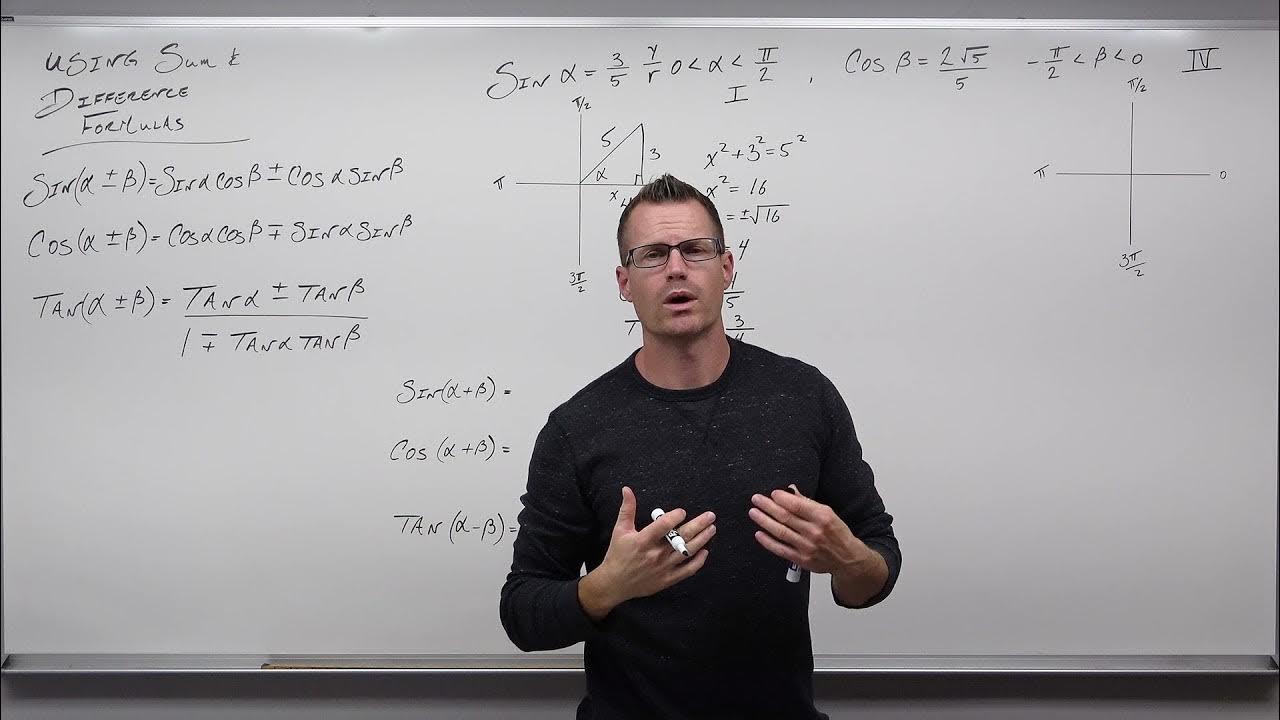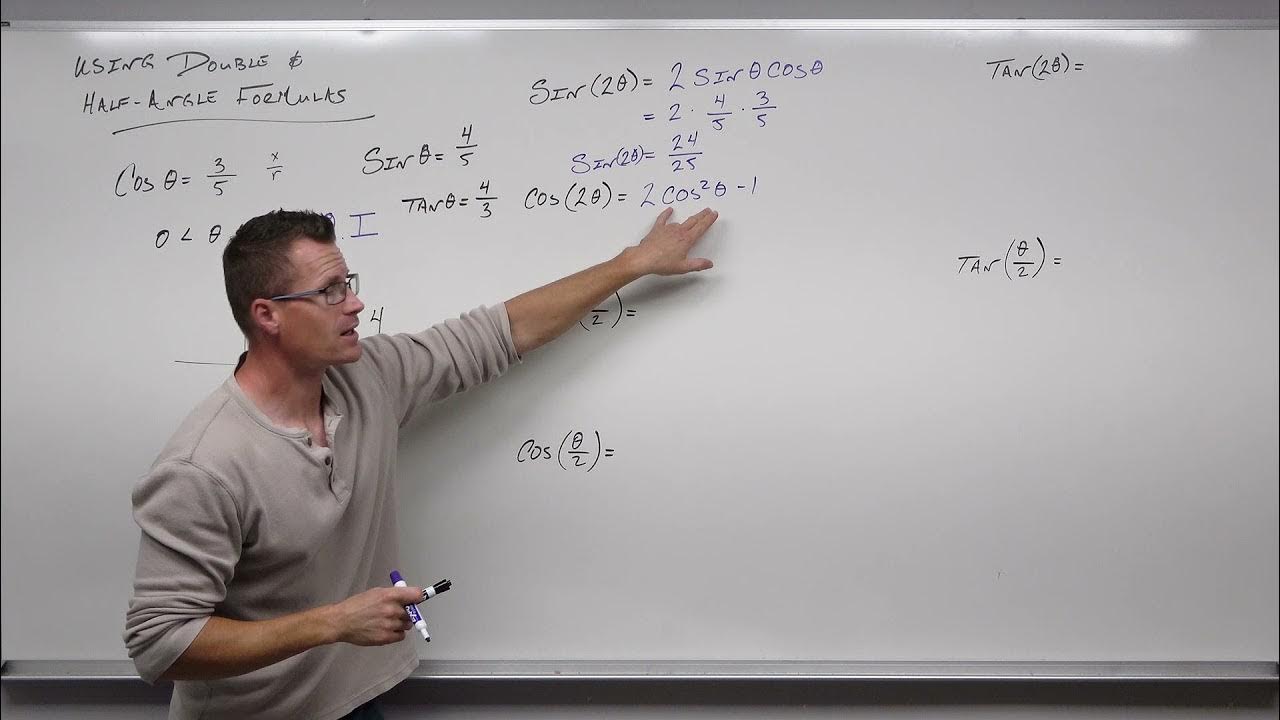Precalc 5.4 Sum and Difference Formulas
TLDRThis video tutorial covers the sum and difference formulas for trigonometric functions, specifically focusing on sine and cosine. It guides viewers through solving problems using these formulas, demonstrates the hand trick for finding exact values, and emphasizes the importance of correctly applying the formulas. The video also includes examples of rewriting expressions and finding exact values when angles are not explicitly given.
Takeaways
- 📚 The video covers the sum and difference formulas for trigonometric functions, specifically sine, cosine, and tangent of two angles being added or subtracted.
- 📝 It's recommended to have a formula sheet handy while watching the video and working through the notes and homework.
- 🔍 The first slide in the video lists all the sum and difference formulas, which are crucial for solving problems involving trigonometric angle sums and differences.
- 📐 The video demonstrates how to use the sum and difference formulas with an example of finding the exact value of sine for the angle pi/12 using the angles pi/3 and pi/4.
- 🤔 The importance of choosing the right formula and writing it down correctly is emphasized for successful problem-solving.
- 👍 The 'hand trick' is introduced as a method to find the exact values for sine and cosine of specific angles, such as pi/3 and pi/4.
- 📈 The video provides a step-by-step guide to simplifying expressions using the sum and difference formulas, as shown with the example of finding the exact value of cosine for 75 degrees.
- 🔢 The process of rewriting and condensing fully expanded trigonometric expressions using sum and difference formulas is explained.
- 📉 The video includes examples of finding exact values when given sine of one angle and cosine of another without specific angle measurements, requiring the use of triangles and the Pythagorean theorem.
- 📝 The final part of the video focuses on using the sum and difference formulas to find the sine of the sum of two angles when the individual angles' sine and cosine values are given.
- 🎓 The video concludes with a summary of the key points and formulas covered in Section 5.4, ensuring viewers have a clear understanding of the sum and difference formulas.
Q & A
What are sum and difference formulas used for in trigonometry?
-Sum and difference formulas are used to find the sine, cosine, and tangent of the sum or difference of two angles.
Why is it important to use the correct formula when dealing with sum and difference of angles?
-Using the correct formula ensures accurate results when calculating trigonometric functions of angles that are being added or subtracted.
How can you find the exact value of sine of pi/12 using the given script?
-You can find the exact value of sine of pi/12 by rewriting the problem as sine of (pi/3 - pi/4) and then applying the difference formula for sine.
What is the 'hand trick' mentioned in the script, and how is it used?
-The 'hand trick' is a mnemonic device to remember the values of sine and cosine for common angles. It involves associating the position of fingers with the sine and cosine values of those angles.
How do you simplify the expression for sine of pi/12 using the hand trick?
-By finding the sine and cosine values for pi/3 and pi/4 using the hand trick, you can substitute these values into the difference formula for sine and simplify the expression to get the final result.
What is the formula used to find the cosine of the sum of two angles?
-The formula for the cosine of the sum of two angles is cosine(U + V) = cosine(U) * cosine(V) - sine(U) * sine(V).
How can you find the exact value of cosine of 75 degrees using the script?
-You can find the exact value of cosine of 75 degrees by recognizing that 75 degrees is the sum of 30 and 45 degrees and then applying the sum formula for cosine.
What is the purpose of rewriting expressions in the context of sum and difference formulas?
-Rewriting expressions allows you to condense a fully expanded trigonometric expression into a more simplified form, which is easier to work with and understand.
How do you approach finding the exact value of sine of U + V when only sine of U and cosine of V are given?
-You can approach this by drawing triangles for the given angles, using the Pythagorean theorem to find missing sides, and then applying the appropriate sum formula for sine.
What is the significance of drawing triangles when dealing with unknown angles in sum and difference problems?
-Drawing triangles helps visualize the angles and their relationships, making it easier to apply trigonometric ratios and find the necessary values for solving the problem.
How can you simplify the expression for sine of U + V when U and V are between different quadrants?
-By using the appropriate trigonometric ratios for each angle based on their quadrants and simplifying the expression, you can find the exact value for sine of U + V.
Outlines
📚 Introduction to Sum and Difference Formulas
This paragraph introduces the concept of sum and difference formulas in trigonometry. The speaker encourages viewers to have their formula sheets ready while watching the video. The focus is on using these formulas to find the sine and cosine of the sum or difference of two angles. The first example involves finding the sine of pi/12, using the fact that pi/2 equals the sum of pi/3 and pi/4. The speaker demonstrates how to rewrite the problem using these angles and apply the difference formula for sine. The process involves using the hand trick to find the sine and cosine values for these angles and then substituting them into the formula. The result is simplified to a final answer.
📘 Applying Sum and Difference Formulas to Trigonometric Functions
This paragraph delves deeper into applying sum and difference formulas to trigonometric functions. The speaker provides an example of finding the cosine of 75 degrees, using the fact that 75 degrees equals the sum of 30 degrees and 45 degrees. The formula for cosine of the sum of two angles is used, and the speaker illustrates how to find the cosine and sine values for these angles using the hand trick. The expression is simplified to a single fraction, demonstrating the process of combining terms. The speaker also discusses rewriting expressions and condensing them using sum and difference formulas, providing examples with angles pi/7 and pi/6, and 25 degrees and 45 degrees.
📙 Finding Exact Values Using Trigonometric Ratios
The final paragraph focuses on finding exact values using trigonometric ratios without explicitly stating the angles. The speaker uses the example of sine of U and cosine of V, where U is between 0 and pi/2 and V is between pi/2 and pi. Triangles are drawn to represent these angles and their trigonometric ratios. The speaker explains how to use the Pythagorean theorem to find the missing sides of the triangles and then apply the sum formula for sine to find the sine of the sum of U and V. The process involves calculating the ratios for the given angles and combining them to find the final value, which is simplified to a fraction.
Mindmap
Keywords
💡Sum and Difference Formulas
💡Trigonometric Functions
💡Exact Value
💡Hand Trick
💡Ordered Pairs
💡Simplification
💡Cosine of U + V
💡Pythagorean Theorem
💡First Quadrant
💡Second Quadrant
Highlights
Introduction to sum and difference formulas for trigonometric functions.
Recommendation to use a formula sheet while watching the video.
Explanation of sum and difference formulas for sine and tangent of two angles.
Emphasis on using the correct formula and writing it down correctly.
Example problem to find the exact value of sine of pi/12 using pi/2 = 3pi/4 - pi/4.
Demonstration of rewriting the problem using sum and difference formulas.
Use of the hand trick to find sine and cosine values for angles pi/3 and pi/4.
Simplification of the expression to find the final answer for sine of pi/12.
Example to find the exact value of cosine of 75 degrees using 75° = 30° + 45°.
Application of sum formula for cosine to find the exact value.
Use of the hand trick to determine cosine and sine values for angles 30° and 45°.
Simplification of the expression to find the final answer for cosine of 75 degrees.
Explanation of rewriting expressions using sum and difference formulas for cosine.
Example with angles pi/7 and pi/6 to demonstrate the formula application.
Conversion of angles to fractions using a calculator for precise calculations.
Example with angles 25° and 45° to demonstrate the formula application for sine and cosine.
Explanation of finding exact values when given sine of U and cosine of V without specific angles.
Use of triangles to determine the ratios for sine and cosine in different quadrants.
Final calculation to find sine of U + V using the derived ratios.
Conclusion of the notes for Section 5.4 on sum and difference formulas.
Transcripts
Browse More Related Video

Sum and Difference Identities of Sine and Cosine

Formulas for Trigonometric Functions: Sum/Difference, Double/Half-Angle, Prod-to-Sum/Sum-to-Prod

Introduction to Sum and Difference Formulas in Trigonometry (Precalculus - Trigonometry 25)

Using Sum and Difference Formulas in Trigonometry (Precalculus - Trigonometry 26)

Product To Sum Identities and Sum To Product Formulas - Trigonometry

How to Use the Double and Half Angle Formulas for Trigonometry (Precalculus - Trigonometry 28)
5.0 / 5 (0 votes)
Thanks for rating: